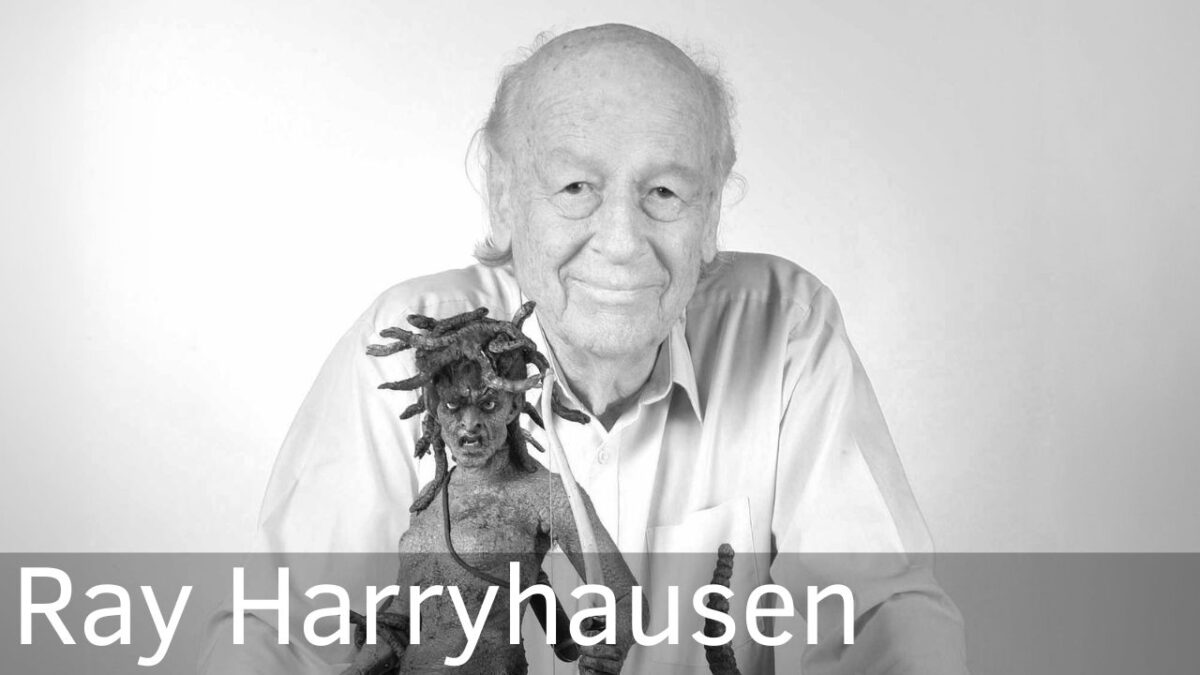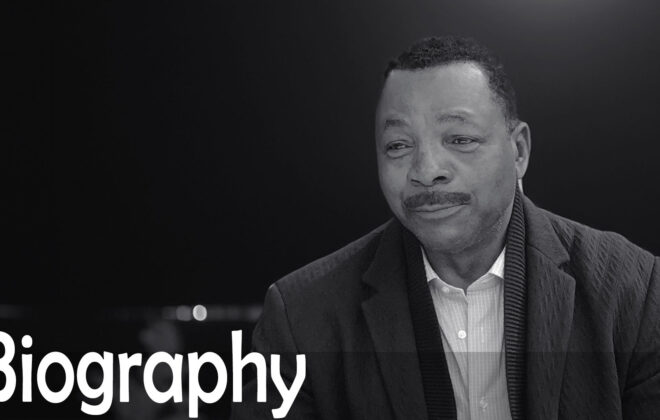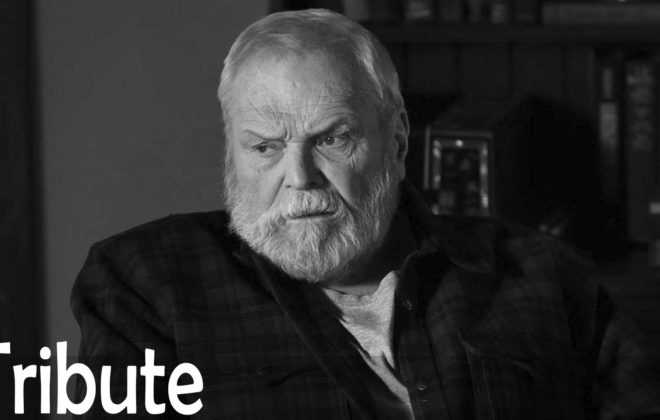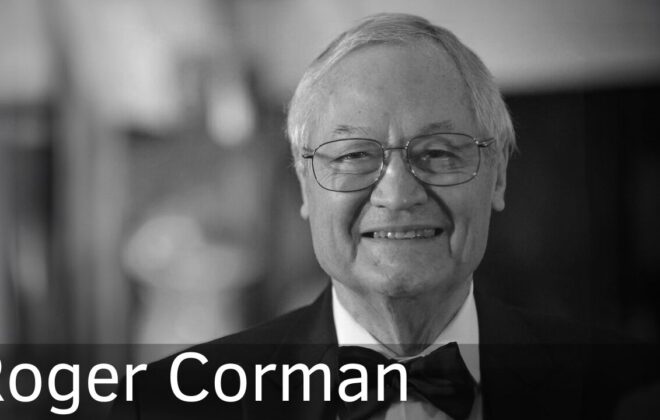Ray Harryhausen Biography
Ray Harryhausen’s impressive and groundbreaking work includes such iconic films as Jason and the Argonauts (1963), One Million Years B.C. (1966), and The Golden Voyage of Sinbad (1973). His innovative stop-motion animation techniques have inspired generations of filmmakers, and his influence on cinema can still be felt today.
Several books have been written and documentaries made about the innovative Ray Harryhausen. In this article, I’ll summarize the history behind his status as the most influential stop-motion special effects animator of all time.
Early Life
Born on June 29, 1920, in Los Angeles, California, Ray Harryhausen’s fascination with stop motion animation began at the age of five, when his parents took him to see The Lost World (1925). Seeing dinosaurs come to life on the big screen left a lasting impression on him that would shape the rest of his life. His parents supported his creative interest in dinosaurs, taking him to museums and the La Brea Tar Pits.
In 1933, Ray saw the original King Kong movie at the Grumman Chinese theater. The groundbreaking special effects of Willis O’Brien ignited a spark within Ray, propelling him towards forging his own path in creating stop-motion creatures. In those days, there was almost no information about O’Brien’s stop motion techniques, so Ray made marionettes of Kong from the movie. He would take his marionettes and give performances to his friends. He then moved into stop motion with animating dinosaurs. His father setup a shop in the garage and over the years, Ray continued to refine his stop motion animation abilities through various projects.
A high school classmate of his was an acquaintance with Willis O’Brien and arranged for an introduction of the two. Ray packed some of his models into a suitcase to show his work. O’Brien gave Ray some feedback, telling him he should study art and more anatomy to improve the look of the muscles of his creatures.
Harryhausen enrolled in art school to improve his drawing and sculpture talents. He studied at Los Angeles City College (LACC), and later studied film in night classes at the University of Southern California (USC). While in school, he met a struggling science fiction writer, Ray Bradbury. Their mutual love for all things science fiction resulted in a lifelong friendship. In school, Harryhausen began his first stop motion film called Evolution. The film had bold ambitions to tell the story of life’s beginnings on earth. It was a 16mm project that was never completed. Once he watched Disney’s Fantasia (1940) and saw its similarities, he stopped making the film.
Films
In 1938, Harryhausen received his first professional gig working on George Pal’s Puppetoons. He would work very long hours, spending two years working on the Puppetoons, animating using the method of replacement animation where the puppets are static and not easily posed. Then he would replace the puppet with an identical one in a new pose.
After Puppetoons, Ray joined the Army, which was gearing up for war after the attack on Pearl Harbor. He worked in a signal core unit and made training films for the military.
After leaving the military, he made a series of short children’s films. The first was Mother Goose. With the help of his father, who constructed the armatures for his models, and his mother, who created their outfits. Each 10-minute film would take approximately 4 months to animate.
In 1945, Ray was contacted by his idol Willis O’Brien to work on the feature film Mighty Joe Young (1949). Ray ended up creating much of the animation himself, estimating to have done 85% of Joe’s animated sequences, according to the documentary The Harryhausen Chronicles (1998).
Similar to King Kong, Mighty Joe Young told the story of a giant gorilla who was taken from the wild and put into the world of humans. Ray showcased his talent by blending animated characters and actors together in Mighty Joe Young. The film was a critical and commercial success, earning Harryhausen widespread recognition for his innovative special effects work. Ray would often act out the movement of Mighty Joe and then transfer his ideas directly to the gorilla. This technique proved to make the giant gorilla a standout performer. Mighty Joe Young is generally seen as a direct representation of the kind-hearted Harryhausen in his youth.
In 1950, Ray dove back into his fairy tales and made The Story of Hansel and Gretel (1951), followed soon after by The Story of Rapunzel (1951), which would prove slightly more daunting a task than his previous short films. Following the completion of Rapunzel, Harryhausen was offered the opportunity to create the visual effects for the science-fiction film, The Beast from 20,000 Fathoms (1953). When making The Beast from 20,000 Fathoms, Harryhausen asked his friend Ray Bradbury to assist with rewriting the script. When reading the script, Bradbury noticed it was a copy of a story he had previously published. The producers then bought the rights from Bradbury to the story to make the film.
This would prove to be the beginning of his split-screen matte technique, later called Dynamation. Though matting and compositing of shots had been done for many years, Dynamation combines live-action footage with animated models, creating the illusion that the creatures are interacting with real-life actors and environments. Harryhausen used a rear-projection setup, projecting live-action footage onto a screen and animating his models frame by frame in front of the projection. The producers were so impressed with his work that they gave Ray a bonus when the film was sold to Warner Brothers. The film was the studio’s second biggest hit in 1953, following the House of Wax (1953).
Ray was introduced to Charles Schneer, who would prove to be one of the most important people in Ray Harryhausen’s career. Charles was working on an idea about a giant octopus that destroys San Francisco. With Harryhausen on board, they created It Came from Beneath the Sea (1955).
Throughout the next few decades, Harryhausen continued to make innovative movies that pushed the limits of what could be achieved with stop-motion animation. In Jason and the Argonauts (a film I loved as a child and still do), Ray takes us on an epic journey into the world of Greek mythology and gives us some of the most iconic creatures in the history of cinema.
In 1966, he made One Million Years B.C. The only film that Harryhausen made for Hammer, breaking a decade-long run of films with producer Charles Schneer. The film is perhaps more famous for its poster featuring Raquel Welch than Harryhausen’s creatures. One Million Years B.C. contains more dinosaurs than any other Harryhausen film.
In 1981, he made Clash of the Titans, another favorite of mine, and a film that would become his last film. The movie included an all-star cast such as Sir Laurence Olivier and Harry Hamlin. Clash of the Titans is a return to the world of Greek mythology and includes some of Harryhausen’s most iconic creatures, including the snake-haired Medusa. An appropriate finale to a remarkable lifetime of work.
Accolades
In 1992, Harryhausen was honored at the Oscars with the Gordon E. Sawyer Award for technical achievement. The award was presented to him by his friend Ray Bradbury. In 2003, he received a star on the Hollywood Walk of Fame. In 2005, he was inducted into The Science Fiction Hall of Fame. Ray Harryhausen received an honorary BAFTA in June 2010. The list continues with numerous awards recognizing his contributions to special effects and filmmaking.
Foundation
In 1986 Ray setup the Ray & Diana Harryhausen Foundation to “look after his extensive collection, to protect his name and to further the art of model stop-motion animation.” The foundation has released books, documentaries, a podcast, and occasionally does exhibitions of Harryhausen’s work.
Legacy
Ray Harryhausen’s influence can be seen in countless films and filmmakers today, and his legacy continues to inspire new generations of filmmakers and special effects artists. His groundbreaking work paved the way for the modern era of visual effects, and his contributions to the world of cinema will be remembered for generations to come.
Ray Harryhausen died on May 7, 2013, in London, England, at the age of 92.
Tags In
Related Posts
Leave a Reply Cancel reply
This site uses Akismet to reduce spam. Learn how your comment data is processed.





